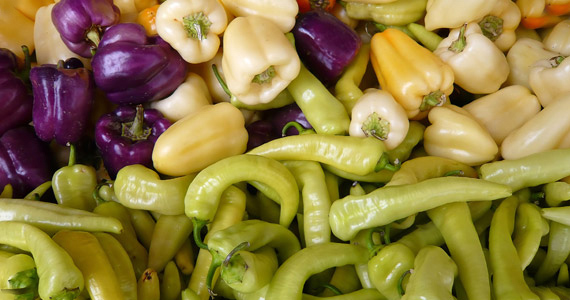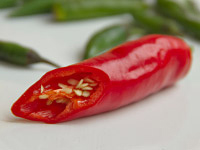Grow chili peppers

5 most cultivated pepper varieties
We Europeans only came into contact with the chili pepper after Columbus discovered America. Since then, more than 3,000 recorded species have been developed. Of these, five are widely cultivated: Capsicum annum, Capsicum baccatum, Capsicum chinense, Capsicum frutescens and Capsicum pubescens. These all have their own special features.
-
capsicum annum
This chili pepper is the easiest to grow. Many well-known chili peppers belong to this type: Bell Pepper (paprika), jalapeño, cayenne pepper, Serrano and all 'waxed' peppers. The flowers are creamy white. -
Capsicum baccatum
This pepper has a fairly fruity taste and can grow very large (a height of 1.5 meters is easily reached). It may not be the most suitable plant for indoors, but this chili pepper is very easy to grow and therefore very suitable for beginners. The flowers of this type have spots on their petals. -
Capsicum chinense
This pepper is one of the hottest of its kind; think, for example, of the Red Savina or the Madame Jeanette. Being a tropical plant, the Capsicum chinense likes a moist environment. It grows quite slowly, needs a relatively long summer and can take a very long time to germinate. -
Capsicum frutescens
The flowers of this plant are greenish. The Capsicum frutescens is quite compact with many branches and - depending on the weather conditions - is between 30 and 120 centimeters high. The most famous peppers from this group are the Tabasco and the Bird's Eye. -
capsicum pubescens
The peppers of this variety are, for example, the Rocotos and they look a bit like bell peppers. This type takes a long time to grow and flower and likes a lot of light per day. Moreover, the temperature for growing this plant is very precise. This is not an easy crop to grow.
Sowing and sprouting
To grow a plant, of course you need seeds. You can separate the good seeds from the bad by dipping them in water. Any seeds that float are best discarded as they are unlikely to germinate.
Let the seeds of the peppers germinate in good sowing soil. You can make this yourself by mixing three parts of potting soil with one part of sand. If you want to use an optimal sowing soil, choose CANNA Terra Seedmix. Fill a coverable seed tray with this soil. Moisten the soil and let it acclimatize to a temperature of about 20°C.

Divide the seed of the peppers over the seed tray, fill it with a maximum of half a centimeter of sowing soil or CANNA Terra Seedmix and cover the tray with, for example, a plastic lid or glass plate. This will maintain the temperature and prevent dehydration. Air the soil occasionally during the day by leaving the cover plate ajar, for example by placing a stick under the plate.
Pepper seedlings need a lot of sun, if you don't have a sunny window, use a pre-growth fluorescent or energy saving lamp. If you use a grow tent, you can sow directly in it. Be careful with the light. If it is too bright, the young plants can dry out or even burn.
Moving seedlings
When the first pair of leaves appears, about fourteen days after sowing, it is time to move the seedlings to a larger pot. We also call this spitting out. Place the plants in pots of 1.5 liters and a diameter of twelve centimeters, filled with a high-quality substrate such as CANNA Terra Professional, Terra Professional Plus or CANNA Coco. If you go for organic cultivation, choose certified potting soil such as the BIOCANNA Bio Terra Plus. Try to damage the carrots as little as possible to avoid stress.
The pepper plant likes a lot of sun, so if the plant is in a larger pot for a day or two, it can just be in full sun. Please note that it does not get too hot in sunny weather. If the temperature exceeds 30 degrees too often, you will get hard, leathery leaves and the plant will stop growing.
Transfer to larger pot
About two to three weeks after transplanting it is time to pot your plant. Place the plant in a larger pot, with a capacity of three to six litres. This ensures that the pepper plants are stable and have an adequate moisture buffer that is large enough for the remaining duration of the cultivation.
After 5 weeks, the plant is so large that it can no longer stand on its own. Use a stick to secure the stem to it. Secure the stem with a clip, but don't do it too tight or you'll pinch the stem.
Grow and prune

Peppers need support during growth. You provide that support by guiding the plant along sticks with clips from the start. This gives the plant the desired shape and at the same time prevents branches from breaking off. If the plant threatens to get too big, you can prune the branches. The plant then sprouts just below the cut. For a beautiful full plant, break the growing points (top 0.5 cm of each branch) every 3 to 4 weeks.
Watering
Pepper is a relatively easy plant to grow. A pot that is too dry is not a problem, as long as the leaves of the plant do not droop. If this does happen once, it's not a big deal. Drought stimulates flower formation, resulting in a richly flowering plant. He also doesn't mind too wet, as long as it's not for days on end. Then too little oxygen reaches the roots, causing them to die and the plant to stop growing.
It is best not to water a pepper plant too often, and a lot of water at a time. By letting the plant dry out every time and then watering it enough again, you ensure that you get a compact plant with many flowers. In addition, it makes the peppers sharper in taste.
Temperature, light and humidity
Jalapeño originates from the tropical part of Mexico, the Penis pepper is a cultivated cultivar from the United States. These pepper plants grow best at an average daytime temperature of 25°C. The night temperature must be at least 16°C. Both peppers grow best at a relative humidity (RH) of 70%. In a grow tent, the RH is usually lower, around 45%. You can increase the humidity with a small layer of water on the ground or a nebulizer.
Dry peppers
You are probably not using the entire crop fresh. What you don't use in the short term, you can dry quite easily. Thread a thread through the stems with a needle. Then hang the peppers to dry in a dark place, for example in the attic or basement. When they are completely dry, clean them well and store them in glass jars. This way you can store the peppers for years.
Diseases and plagues
Fungus gnats (peat flies) occur in almost every potting soil. These are not harmful to the plant and disappear automatically. Furthermore, the plant can suffer from thrips , small organisms. These give small spots on leaves and fruit.


